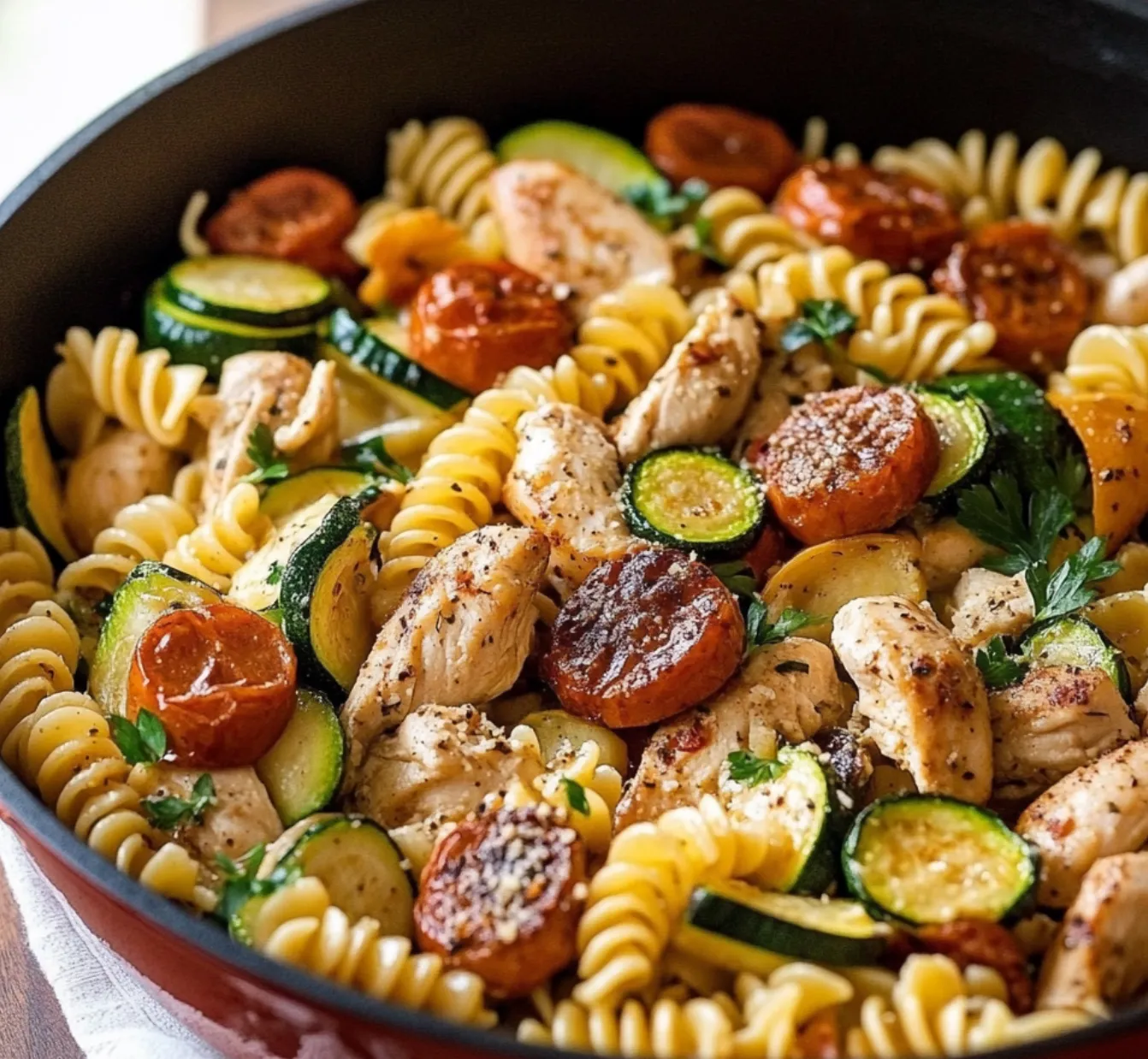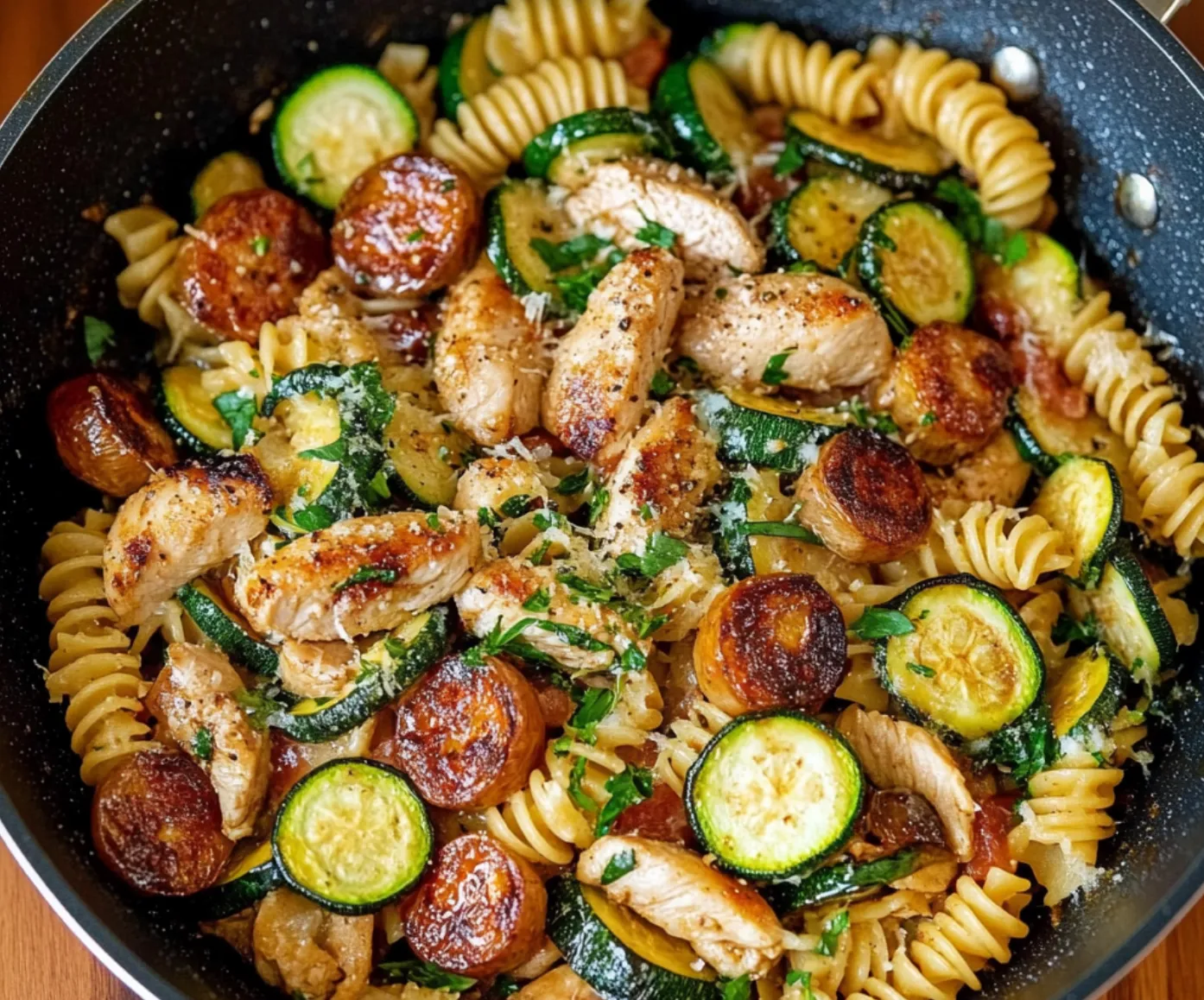 Pin it
Pin it
This one-skillet chicken zucchini pasta has become my weeknight dinner superhero, combining fresh summer vegetables with savory Italian sausage for a complete meal that needs just one pan.
I discovered this recipe during a particularly hectic summer when my garden was overflowing with zucchini. Now it appears on our table at least twice a month during zucchini season because everyone cleans their plate every time.
Ingredients
- Olive oil: Provides the base for sautéing without overwhelming the other flavors
- Italian style chicken sausages: Deliver protein and seasoning without requiring additional spices
- Diced onion: Creates the aromatic foundation, look for firm onions with tight skin
- Minced garlic: Adds essential flavor, use fresh cloves for the best taste
- Crushed red pepper flakes: Bring optional heat, adjust to your family's preference
- Chicken broth: Forms the cooking liquid and sauce, choose low sodium to control salt
- Radiatore pasta: Captures the sauce in its ridges, any small shape works well
- Fresh zucchini: Adds color and nutrition, select firm medium-sized ones
- Lemon juice: Brightens all the flavors, use fresh for best results
- Parmesan cheese: Creates creaminess without adding cream, use freshly grated if possible
- Grape tomatoes: Burst with color and sweetness, halve them for better distribution
- Fresh basil: Provides the perfect finishing touch, use the most vibrant leaves
Step-by-Step Instructions
- Brown the proteins and aromatics:
- Heat your olive oil in a large skillet over medium heat until it shimmers. Add the sliced chicken sausage discs and diced onion together, cooking for about 5 minutes. The sausage should develop a golden brown crust and the onions should become translucent. This step builds the flavor foundation for the entire dish.
- Season the base:
- Sprinkle in the salt and red pepper flakes, then add the minced garlic. Cook for just one minute, stirring constantly to prevent the garlic from burning. You'll know it's ready when the aroma fills your kitchen. The garlic should become fragrant but not brown.
- Create the cooking liquid:
- Pour the chicken broth into the skillet, using a wooden spoon to scrape all the browned bits from the bottom of the pan. These caramelized pieces contain concentrated flavor that will enhance your sauce. Bring the mixture to a vigorous boil before moving to the next step.
- Cook the pasta:
- Add your uncooked pasta directly to the boiling broth. Stir frequently to prevent sticking and ensure even cooking. The pasta will absorb the flavorful broth as it cooks for approximately 10 minutes. It should be nearly tender but still have a slight firmness before adding the zucchini.
- Add the vegetables:
- Stir in the chopped zucchini and continue cooking for 3 minutes. The zucchini will become tender but maintain some texture, while the pasta finishes cooking. Most of the broth should be absorbed, leaving just enough to create a light sauce that coats the pasta.
- Finish with fresh elements:
- Remove from heat and stir in the lemon juice, most of the Parmesan cheese, and the halved grape tomatoes. The residual heat will warm the tomatoes without turning them mushy. The lemon juice and cheese create a light, creamy sauce that brings everything together.
- Garnish and serve:
- Sprinkle the fresh basil and remaining Parmesan over the top just before serving. The basil will release its aroma from the heat of the dish without losing its bright color and flavor.
 Pin it
Pin it
The secret to this dish is how the starch from the pasta combines with the chicken broth to create a silky sauce without adding cream. I remember the first time I made this for my Italian grandmother she was skeptical of the one pot method but ended up asking for the recipe after her first bite.
Make Ahead and Storage
This dish maintains its flavor beautifully as leftovers. Store in an airtight container in the refrigerator for up to 3 days. When reheating, add a splash of water or broth as the pasta will continue absorbing liquid as it sits. I often make a double batch specifically to have quick lunches throughout the week.
Smart Substitutions
This recipe welcomes adaptation based on what you have available. Try yellow squash instead of zucchini, or add bell peppers for extra color and vitamins. For a vegetarian version, use vegetable broth and replace the chicken sausage with plant-based sausage or a can of white beans. The pasta shape can be anything small that cooks in about 10 minutes just adjust cooking time accordingly.
Perfect Pairings
While this dish stands alone as a complete meal, it pairs wonderfully with a simple green salad dressed with lemon vinaigrette. For a more substantial dinner, serve with crusty garlic bread to soak up any remaining sauce. A glass of crisp Pinot Grigio or light Sauvignon Blanc complements the fresh flavors without overwhelming them.
 Pin it
Pin it
Enjoy creating this one-skillet masterpiece with your loved ones!
Frequently Asked Questions
- → Can I use a different type of pasta in this dish?
- Yes, any small pasta shape works well in this recipe. Try farfalle, penne, orecchiette, or rotini. Cooking times may vary slightly, so test for doneness before adding the zucchini.
- → How can I make this dish vegetarian?
- To make a vegetarian version, omit the chicken sausage and use vegetable broth instead of chicken broth. Add extra vegetables like bell peppers or mushrooms for additional flavor and substance.
- → Can I prepare this meal ahead of time?
- While best enjoyed fresh, you can prepare this dish ahead and reheat. The pasta may absorb more liquid when stored, so add a splash of broth when reheating. Add fresh basil just before serving.
- → What can I substitute for zucchini?
- Yellow squash works as a direct substitute. Other quick-cooking vegetables like bell peppers, asparagus, or sugar snap peas can also work well. Adjust cooking times accordingly as some vegetables cook faster than zucchini.
- → Is this dish freezer-friendly?
- This dish can be frozen, though the texture of the zucchini and pasta may change slightly upon thawing. For best results, slightly undercook the pasta before freezing and add fresh herbs after reheating.
- → How spicy is this dish?
- The red pepper flakes add a mild heat that most people find pleasant. The recipe notes they're optional, so you can omit them entirely for no spice or increase the amount for more heat according to your preference.
